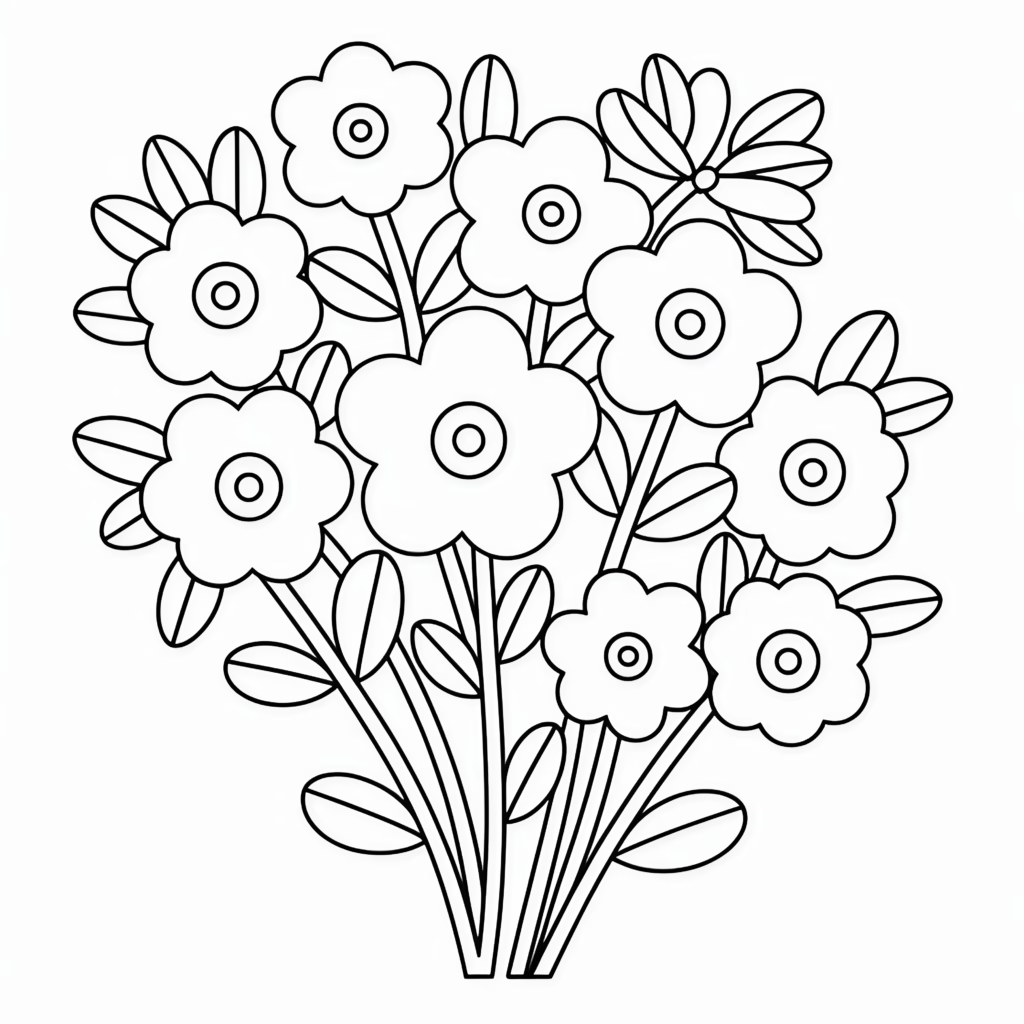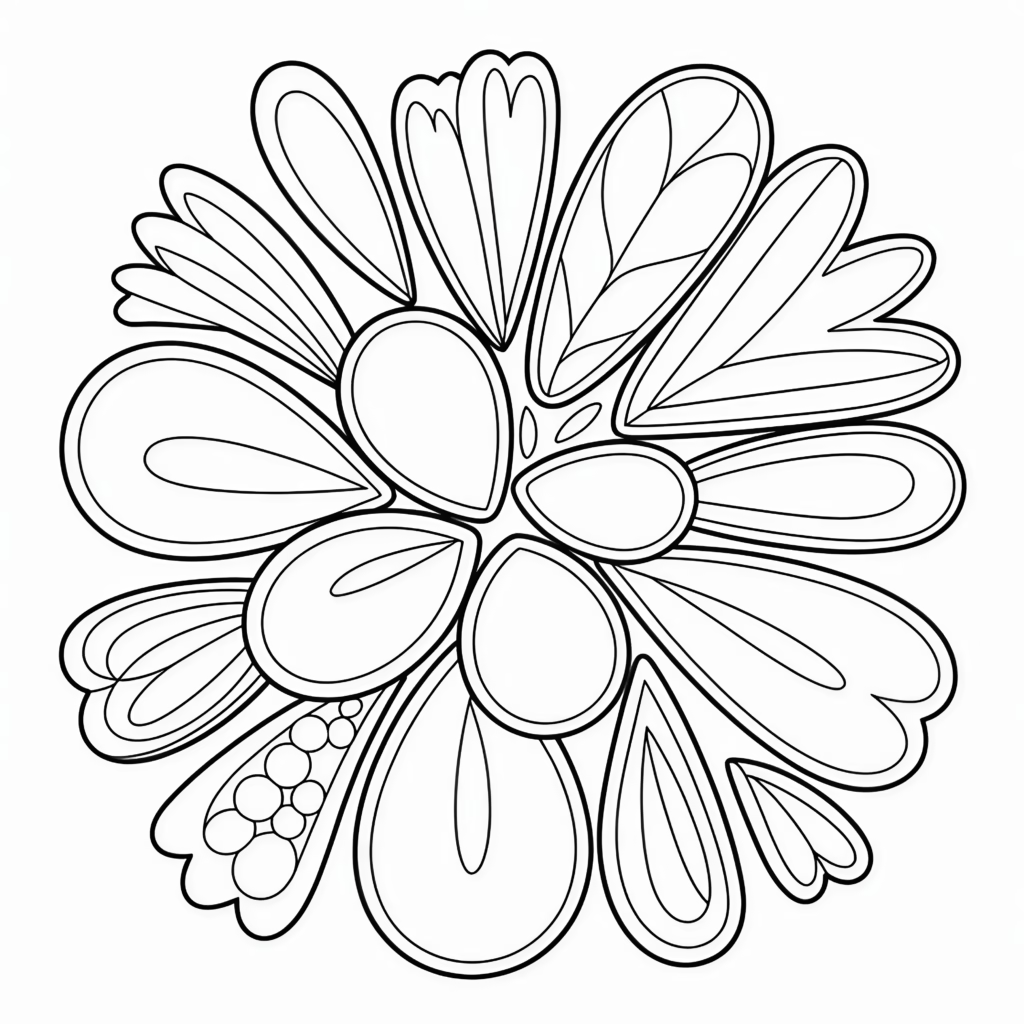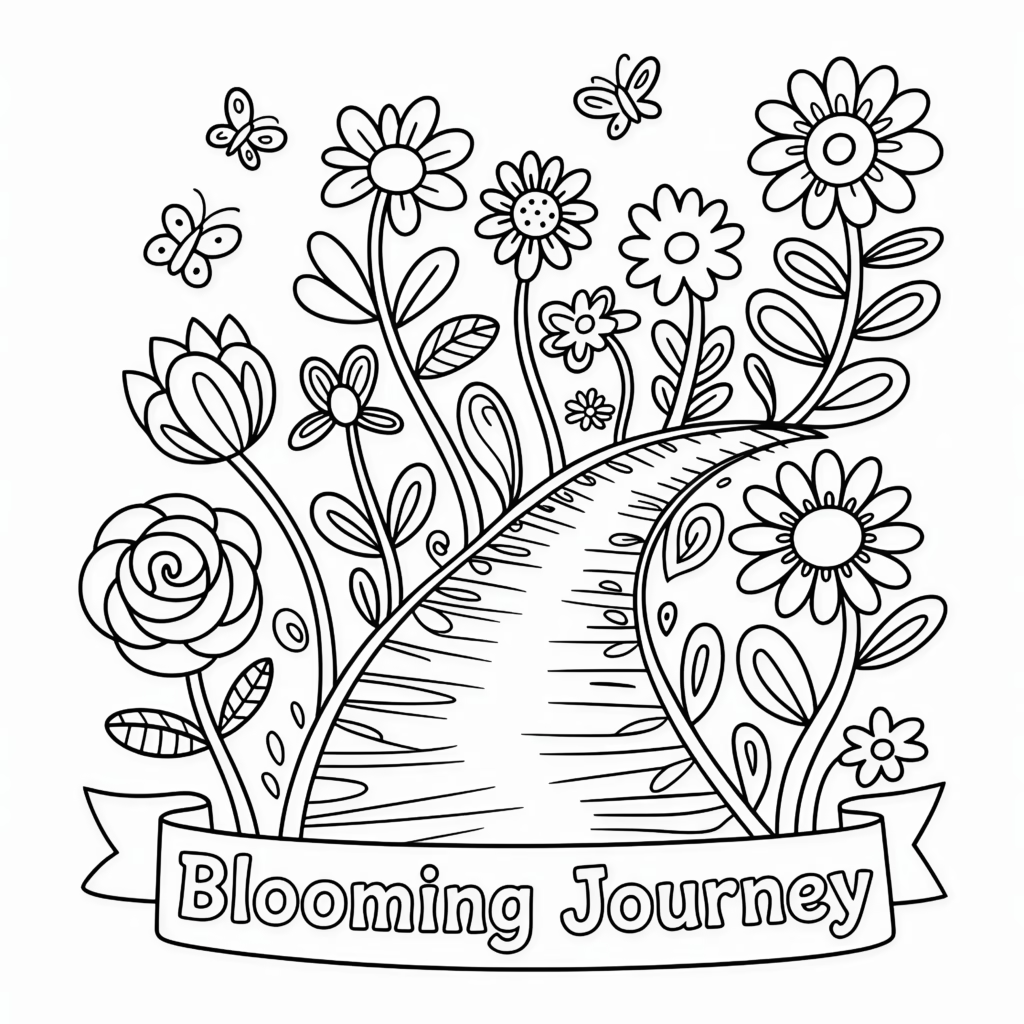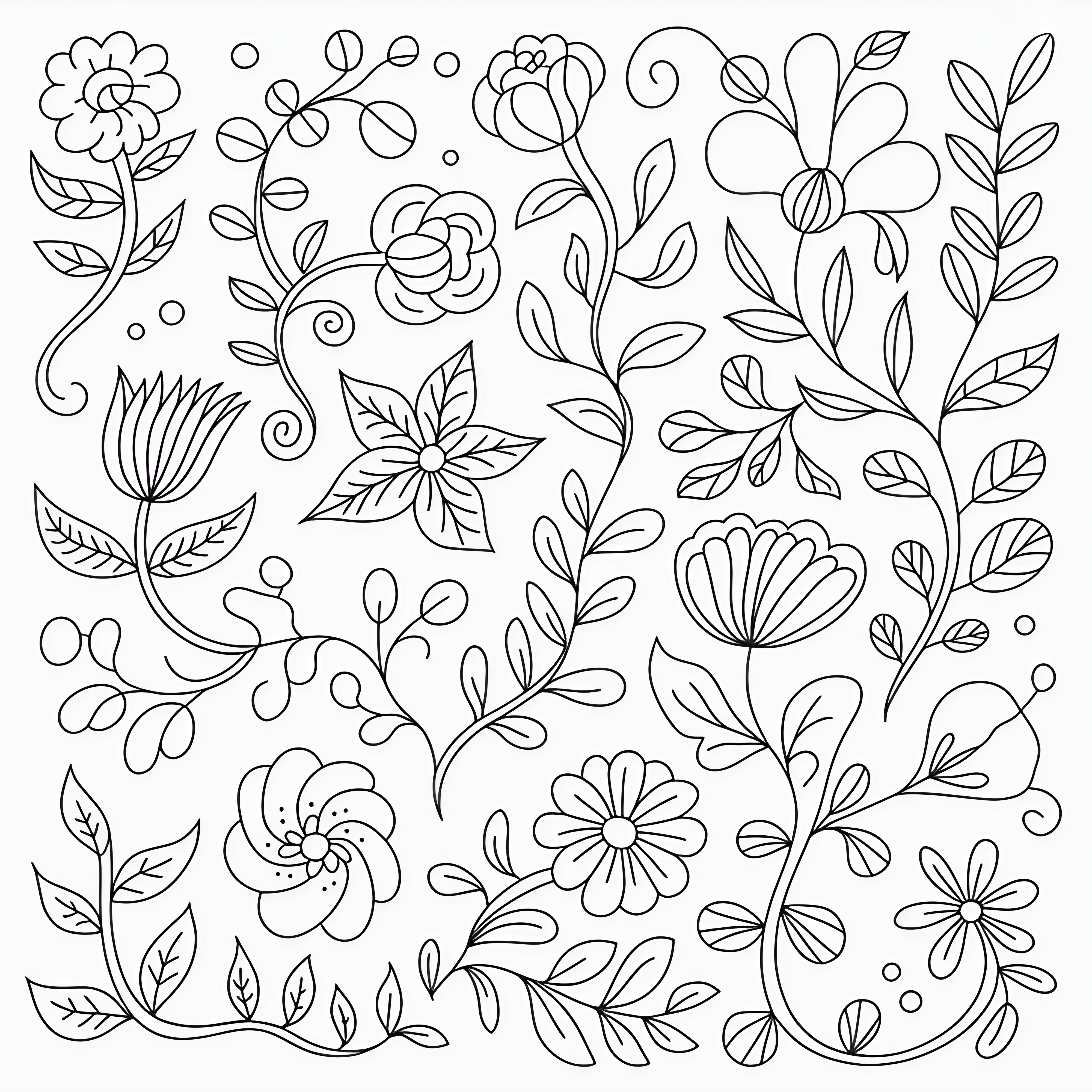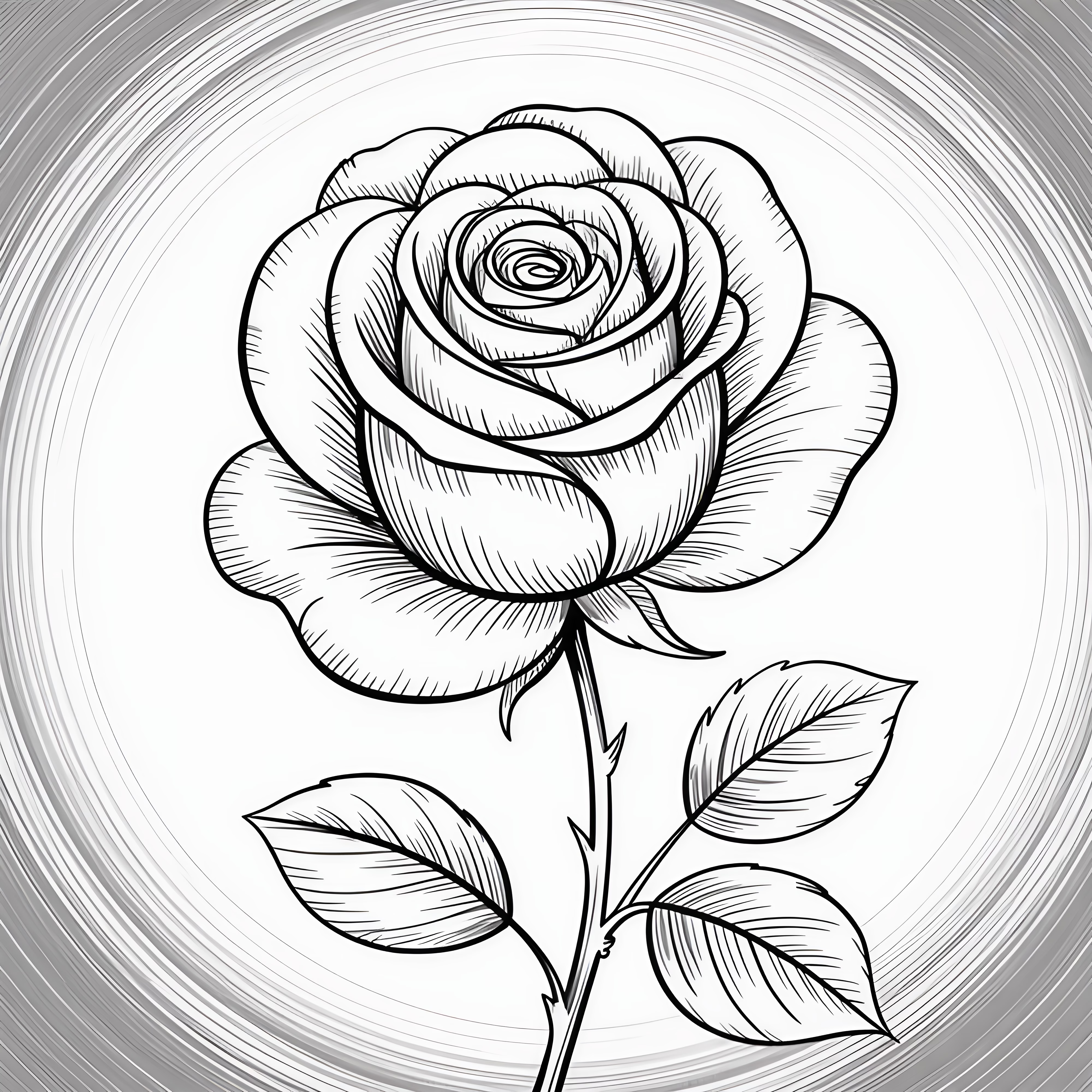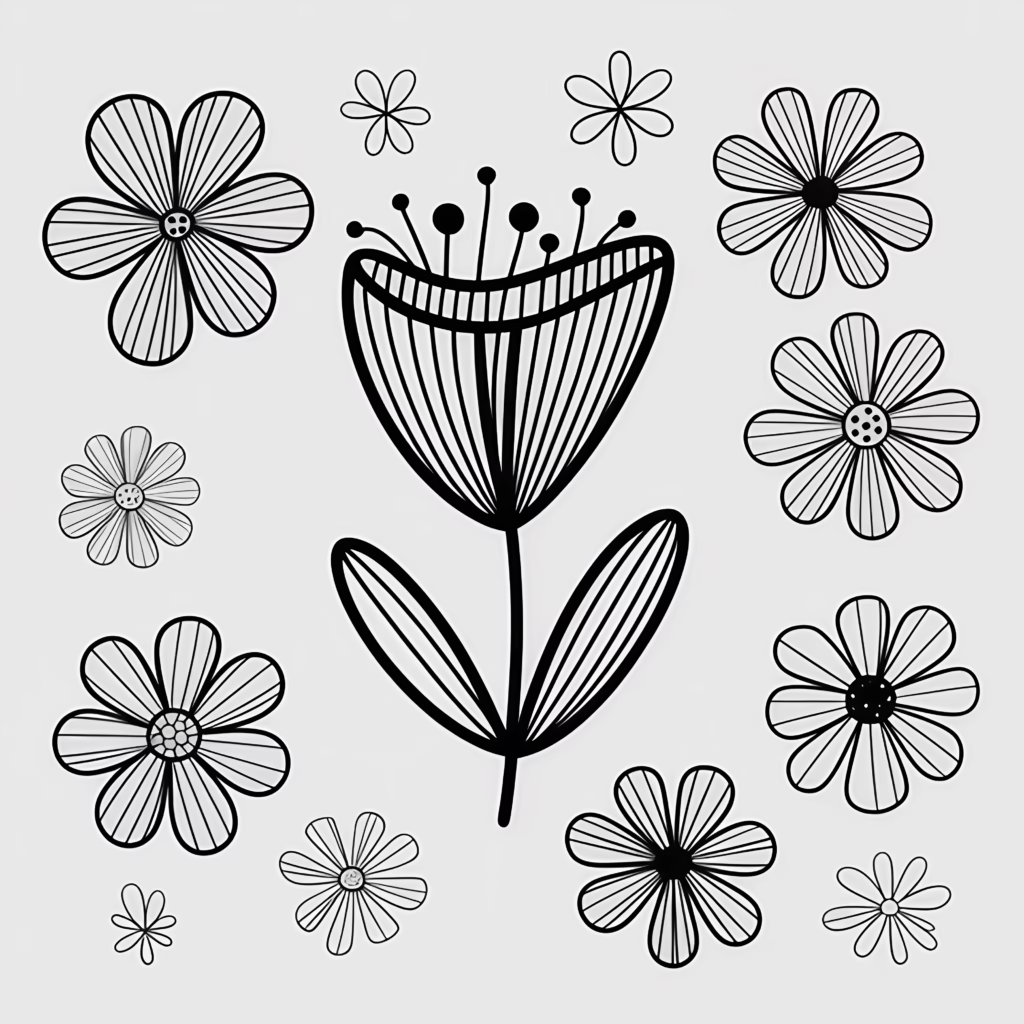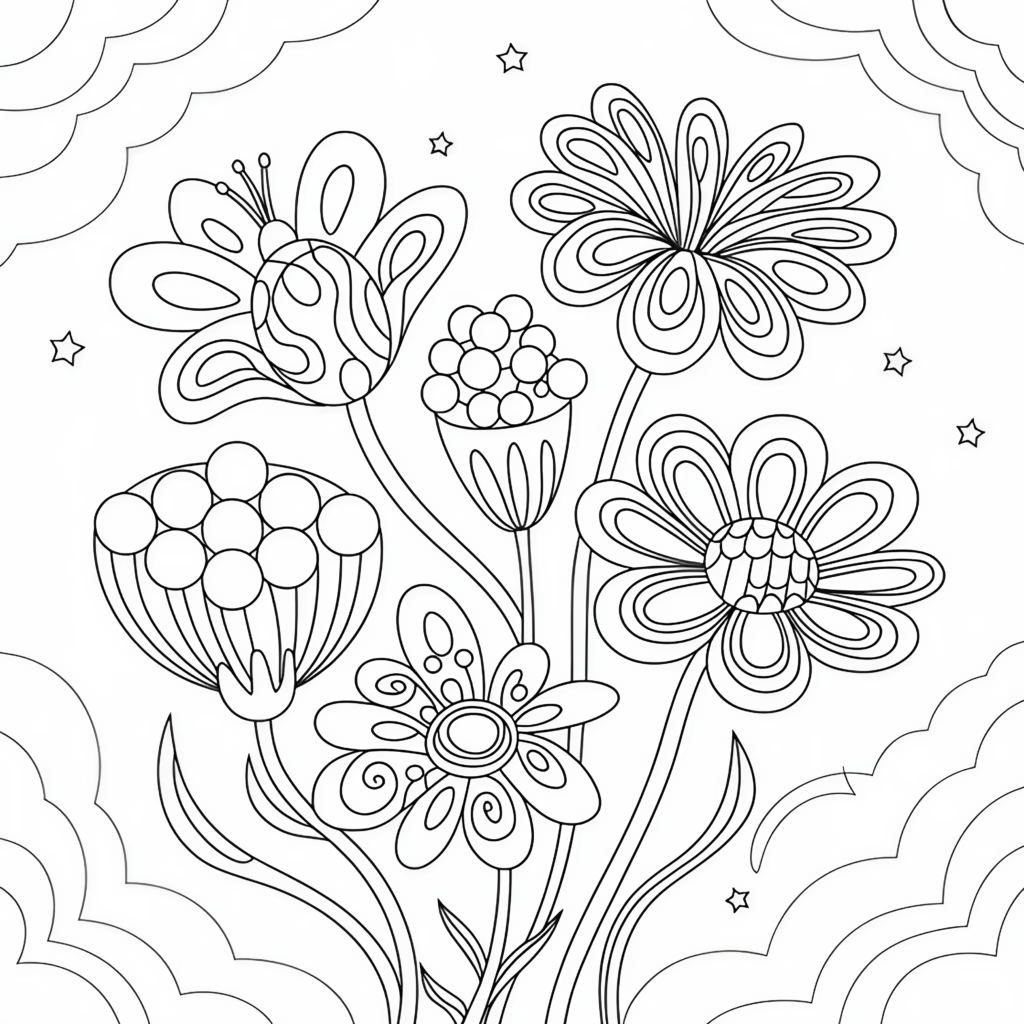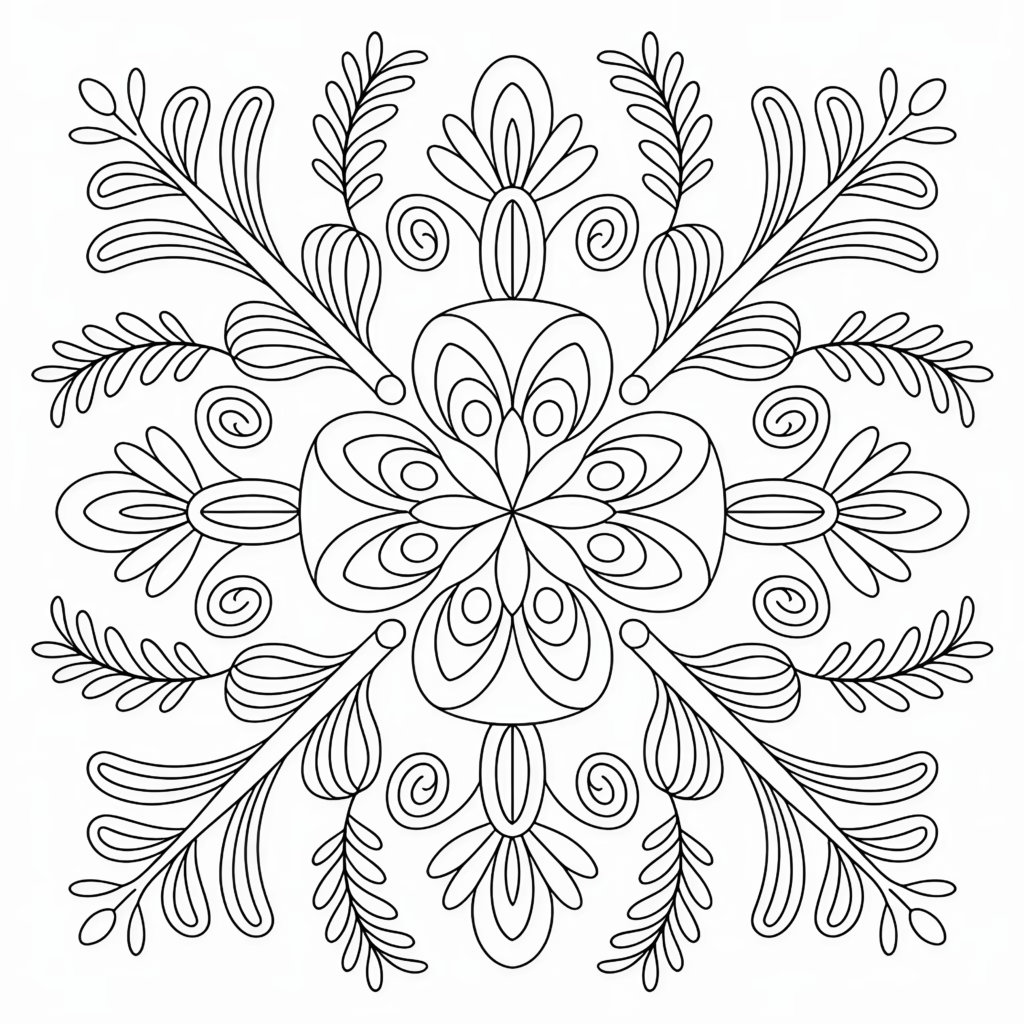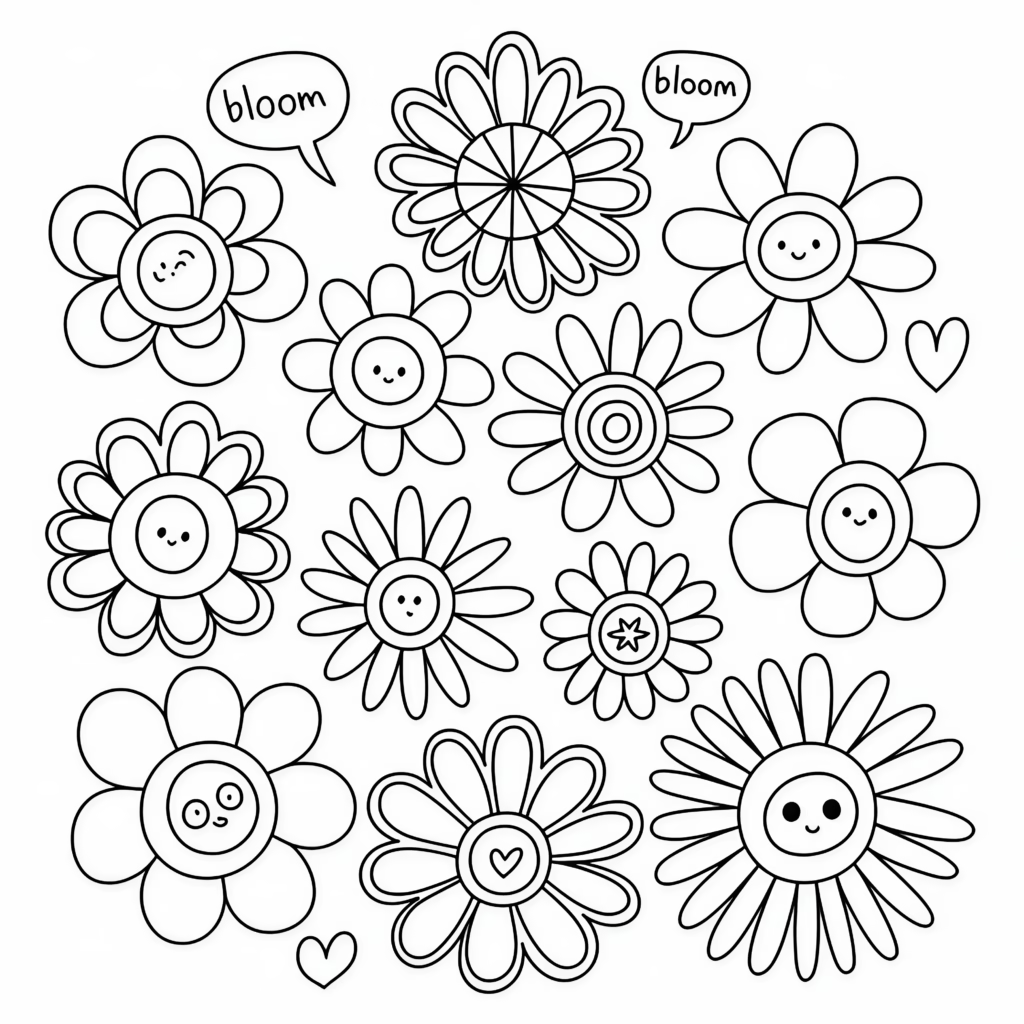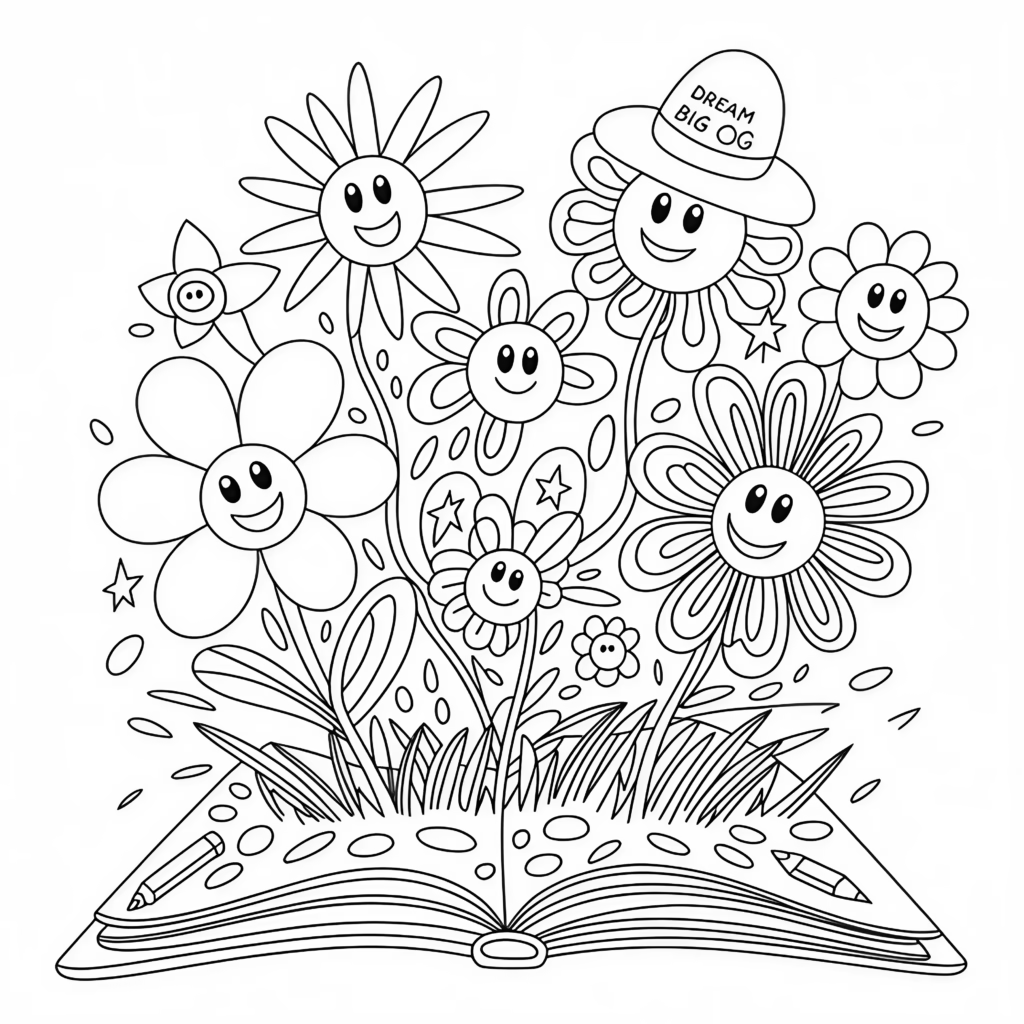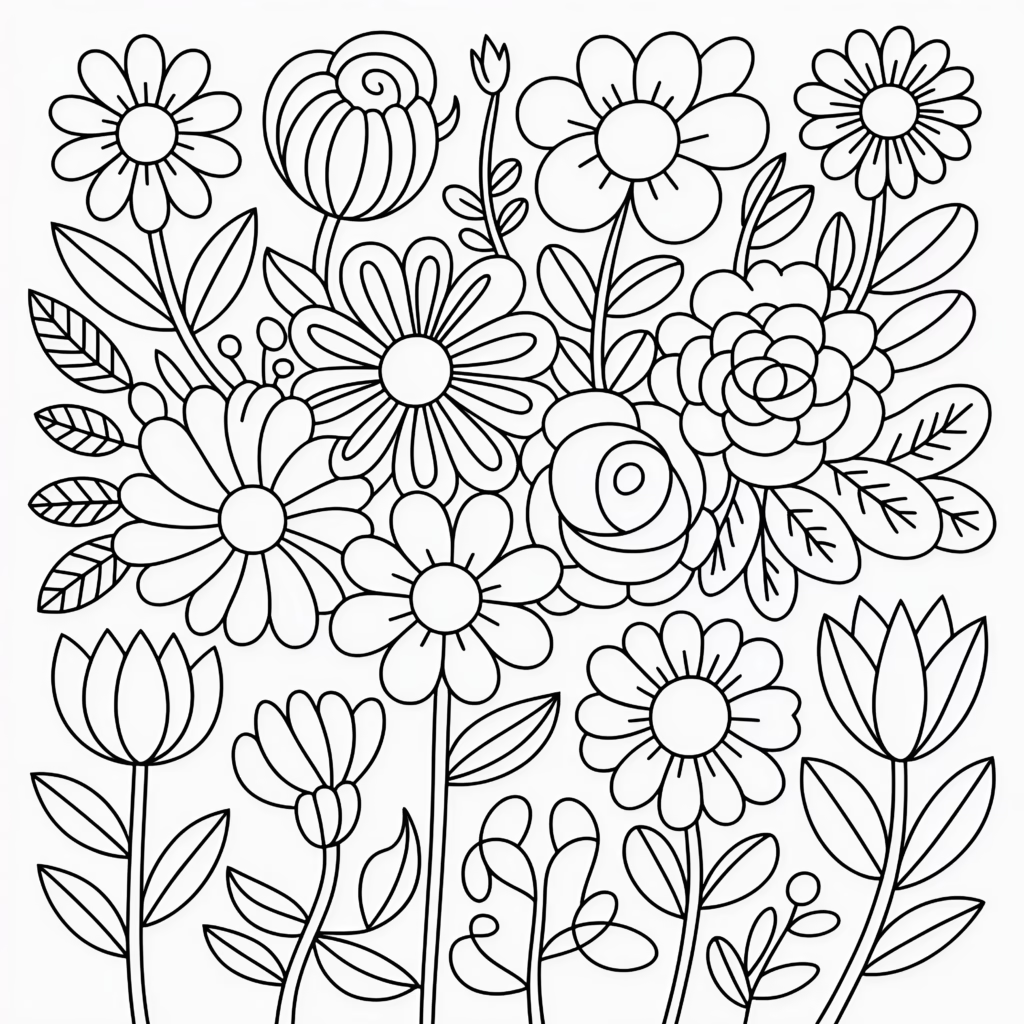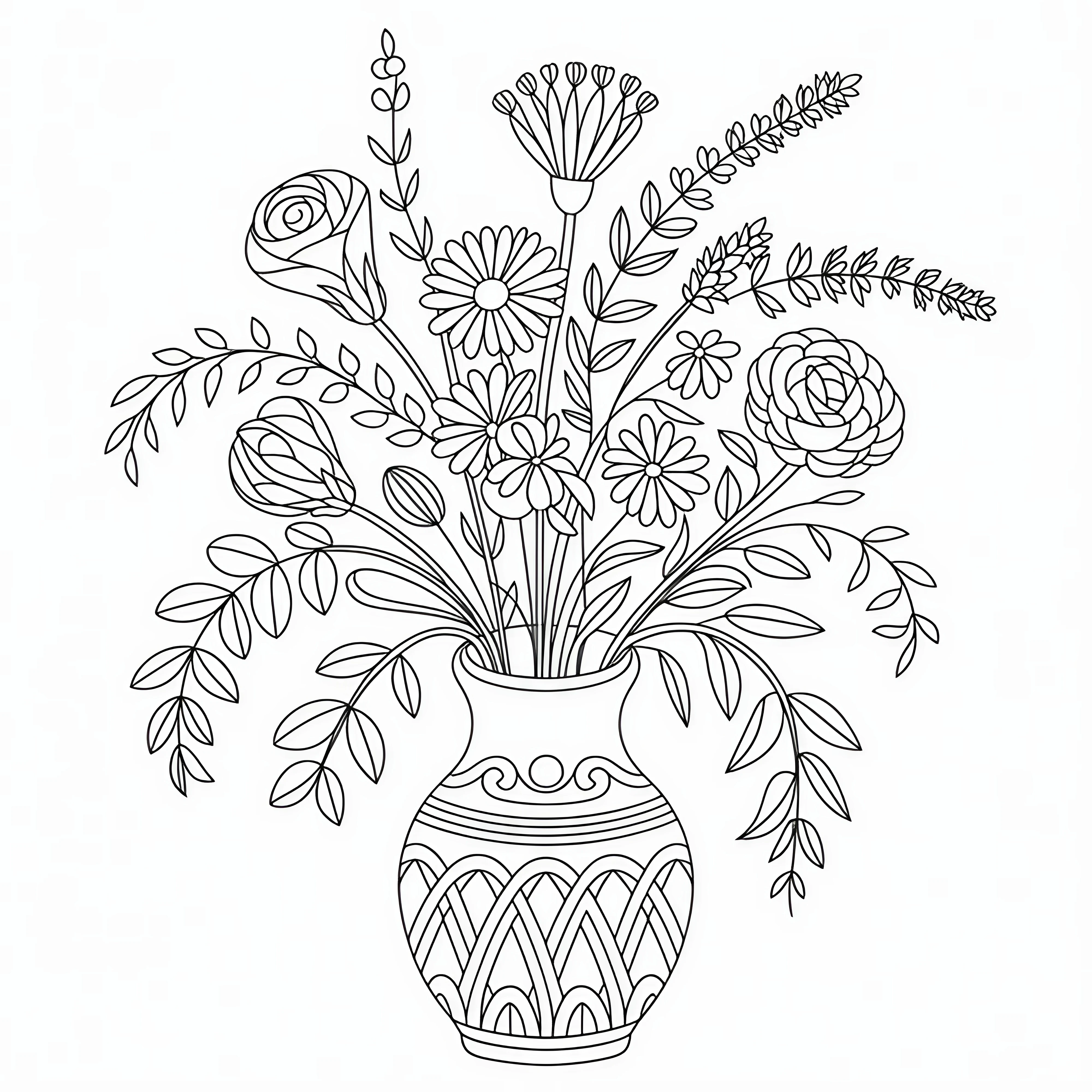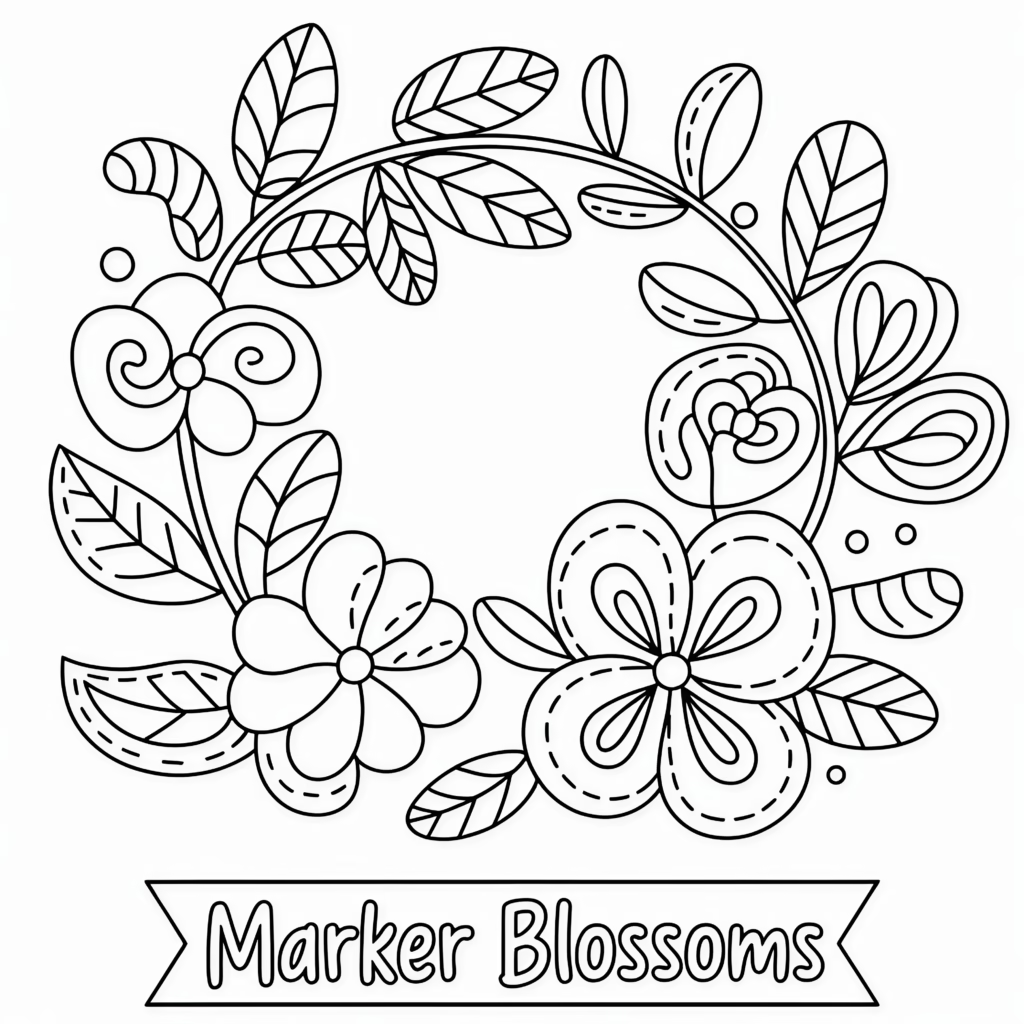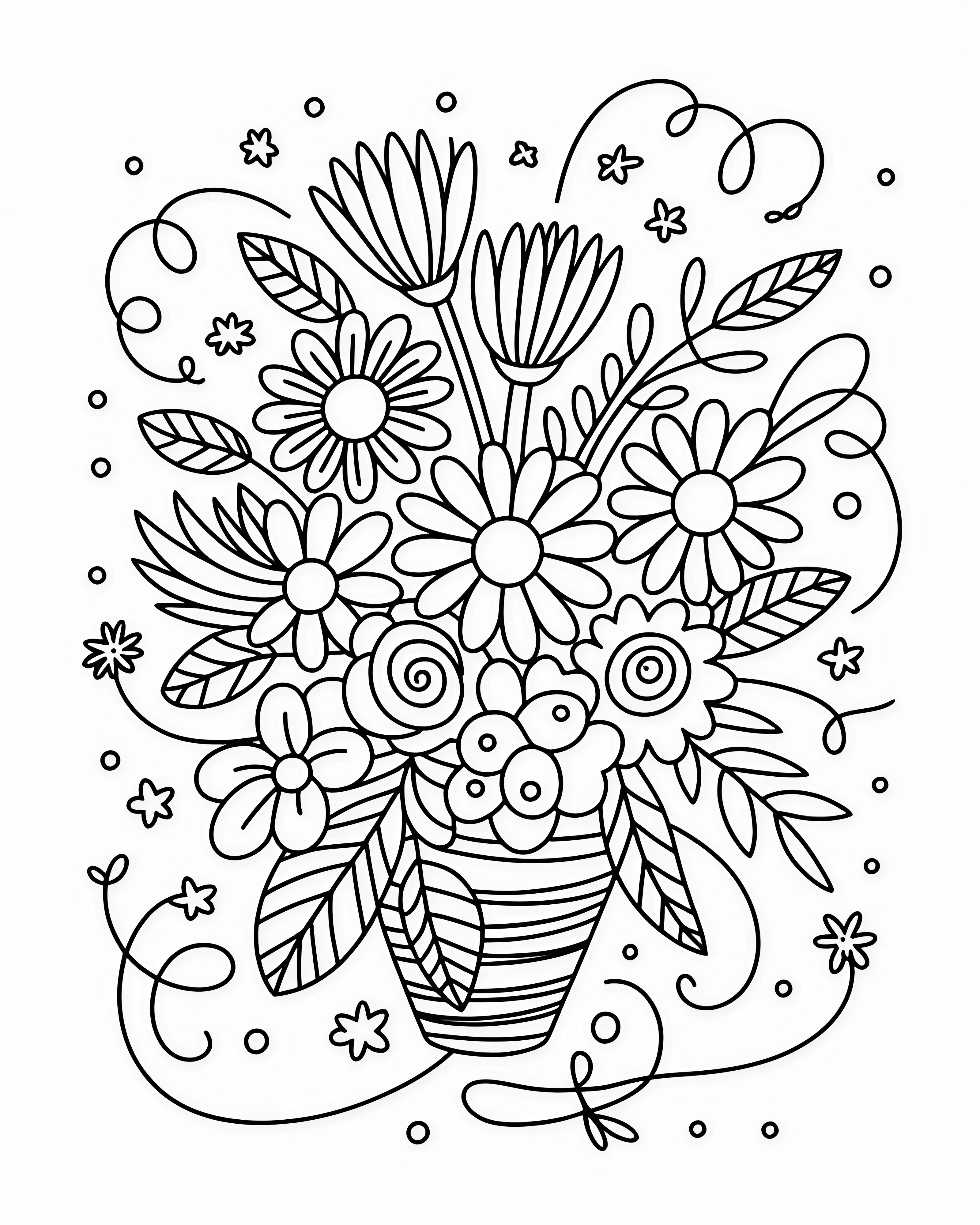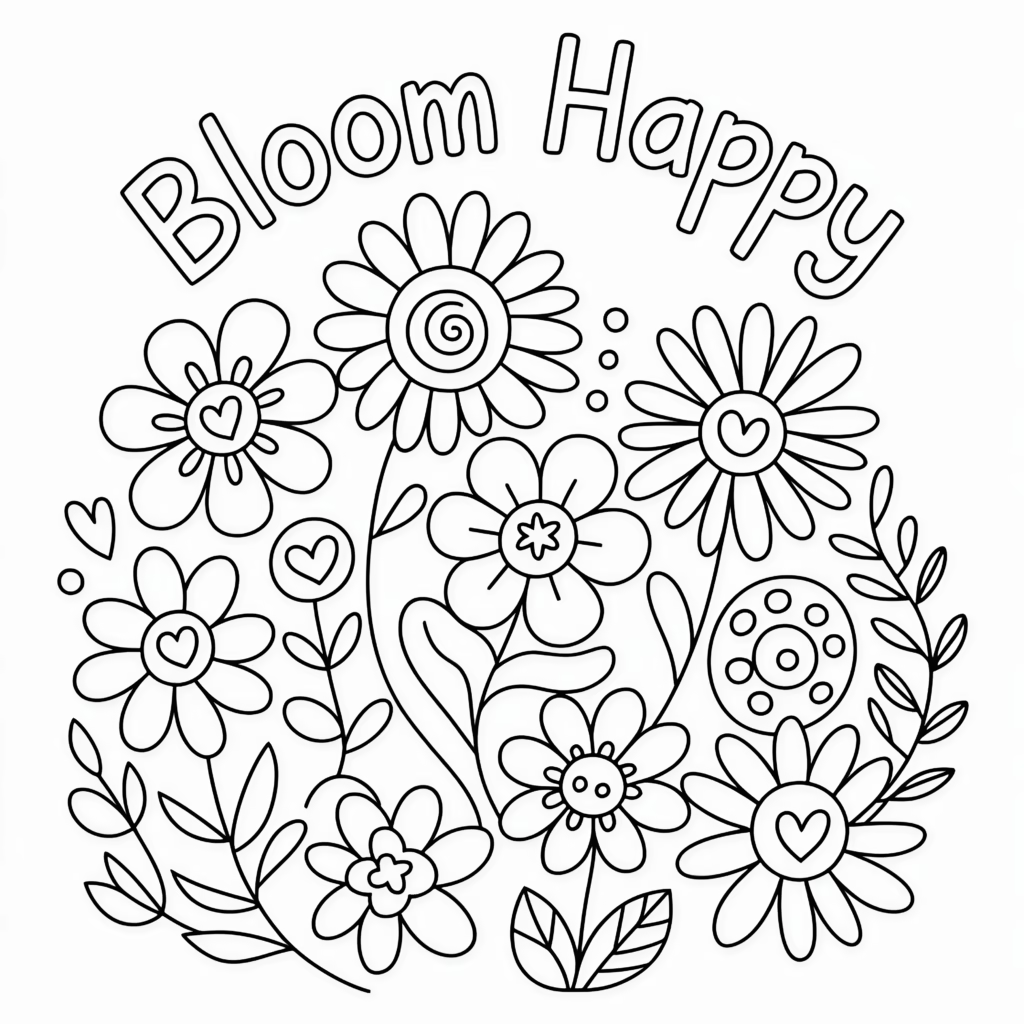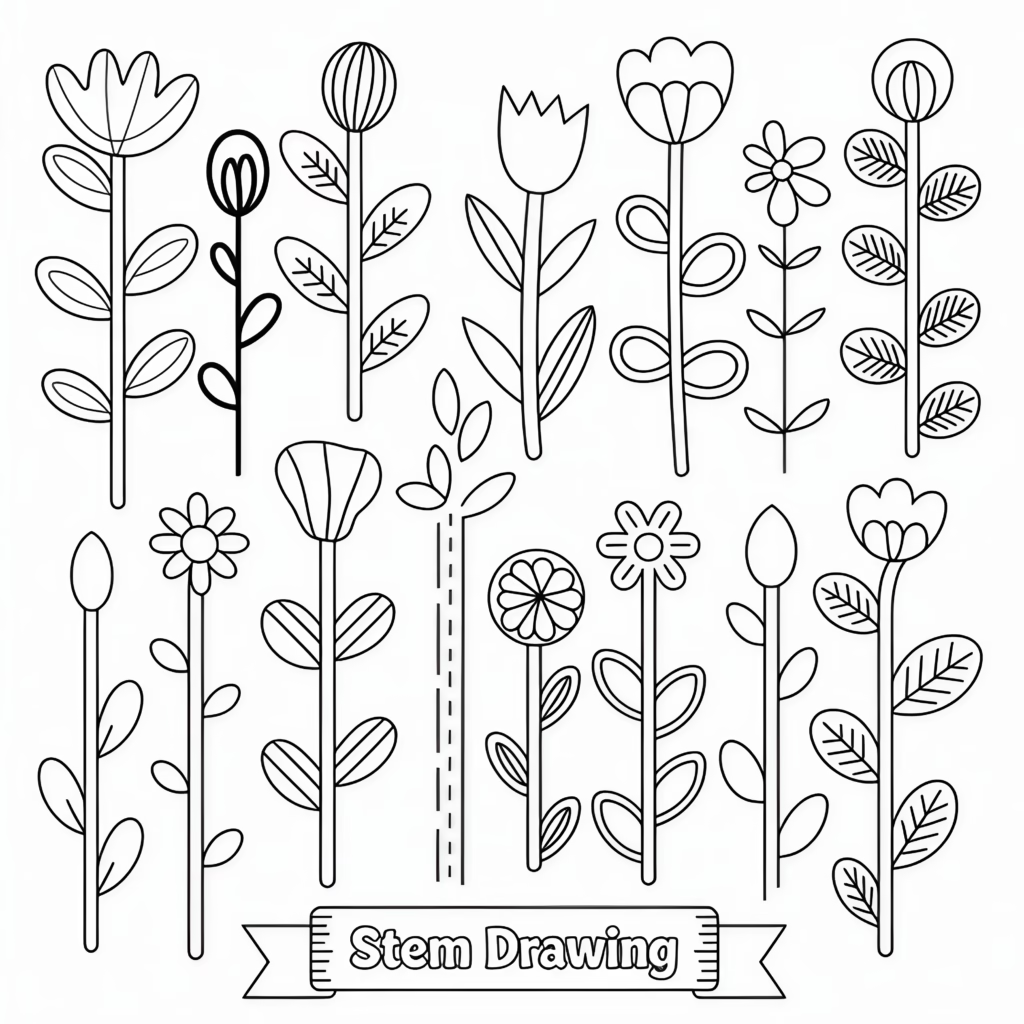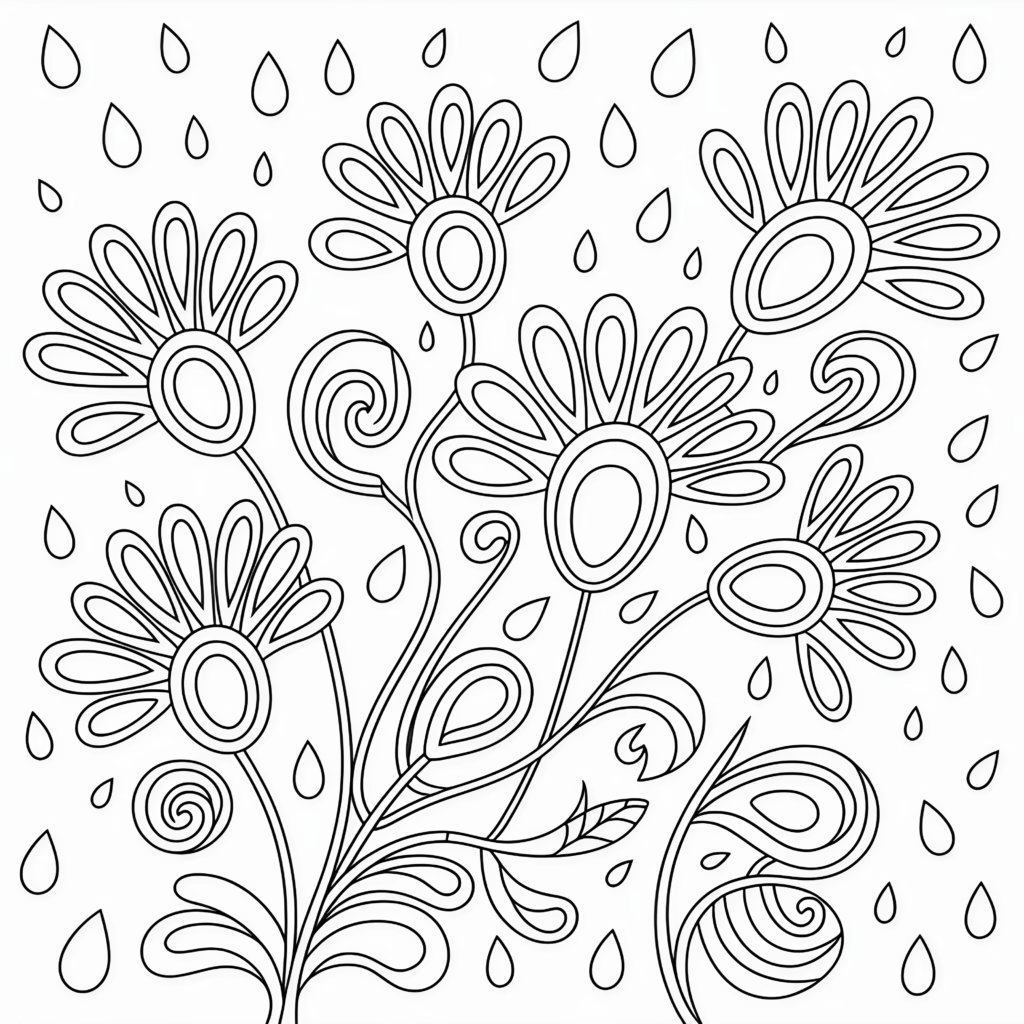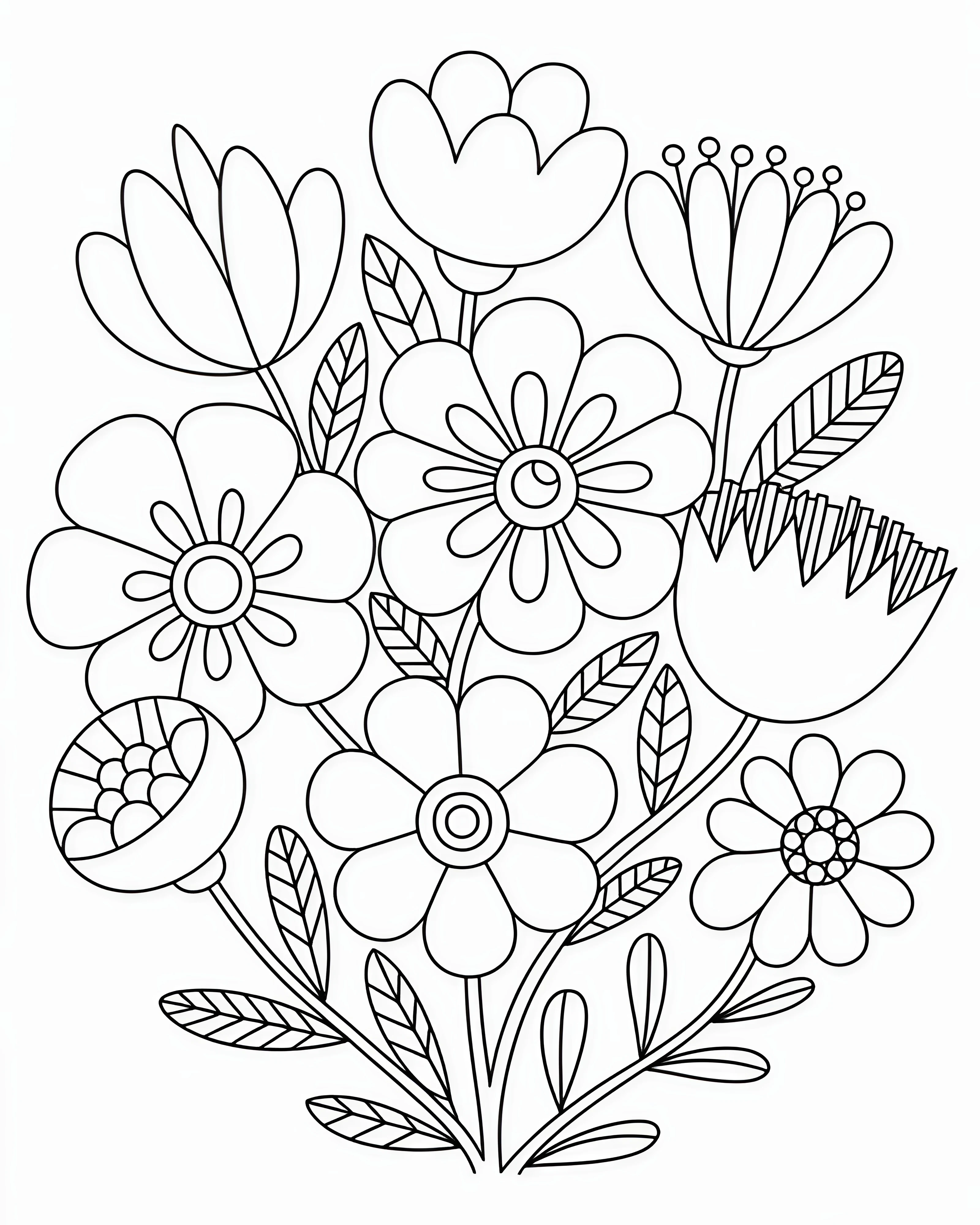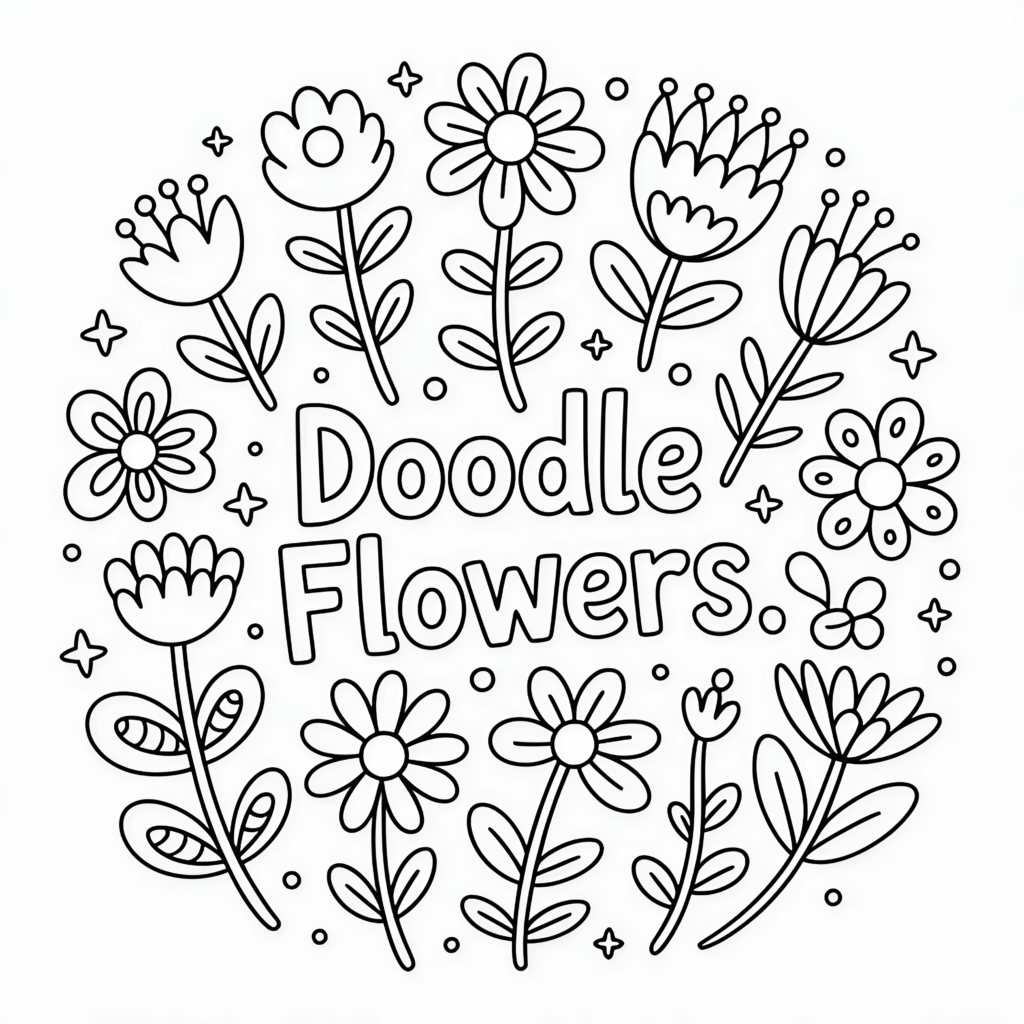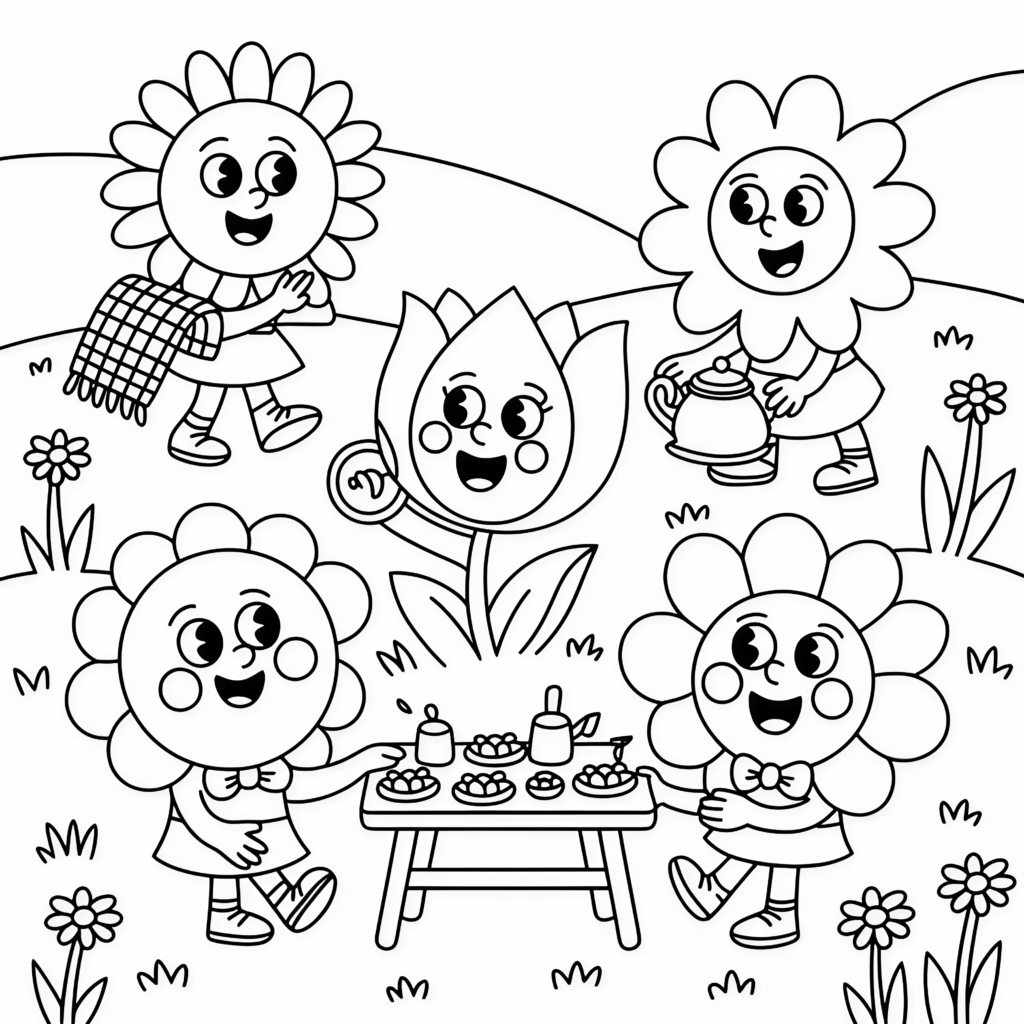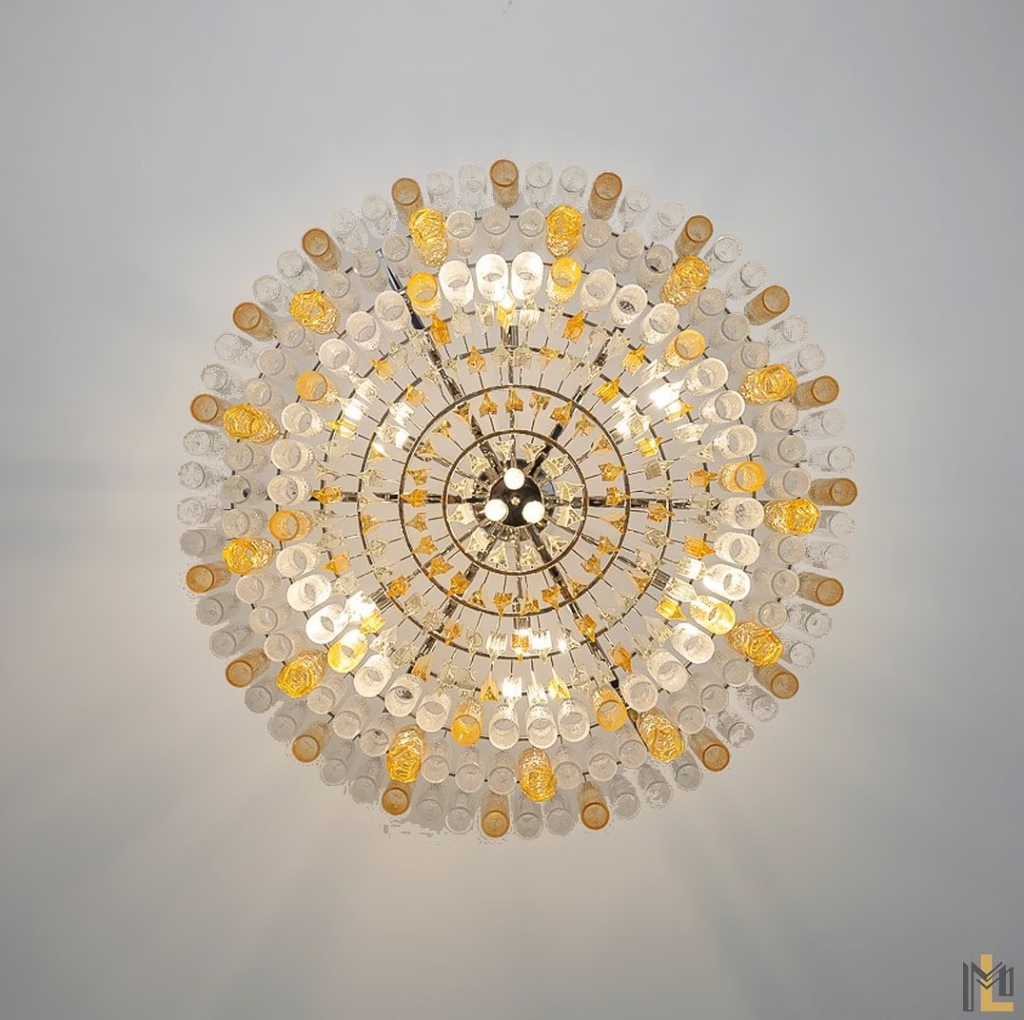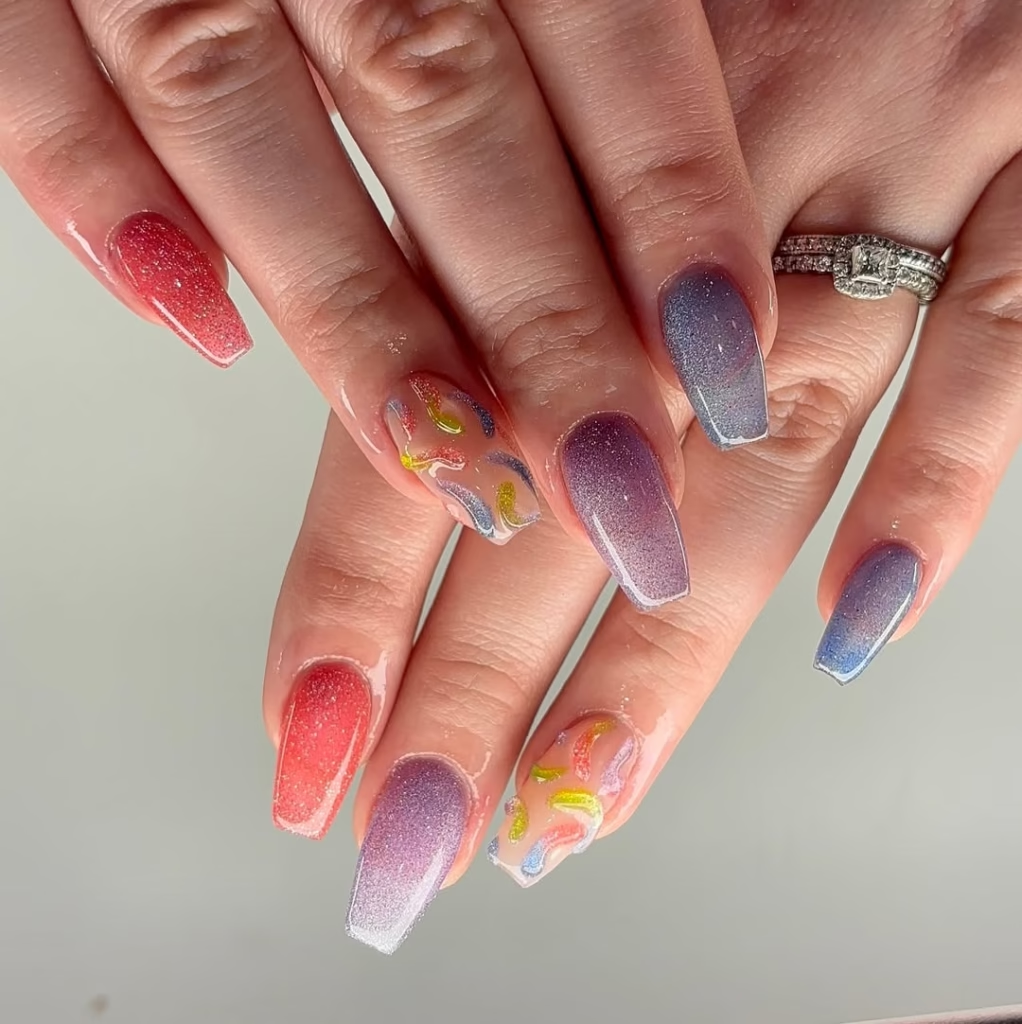Doodling flowers is a fun art activity for beginners that can inspire you to be more creative, and feel the calming benefits of art. Easy doodle flowers involve basic shapes and lines, these can be achieved by anyone no matter how little artistic skill. Begin with the basic shapes: circles, ovals, and teardrops. These are very simple to turn into petals and centres. For example, sketching a tiny circle for the middle and then petals around it makes an adorable little daisy flower. Try playing with petals of different shapes—rounded or pointed or even wavy—for some variation in your doodles. Lines or dots can be added to the center to suck up the look of the flower. Create depth by layering flowers, mixing smaller and larger ones or even overlapping them a bit. Another easy way to take your doodle flowers a step up is to add leaves and stems. Trapezoids or triangles may be obtained from straight or curved stem-like features, with leaf-forms branching. And remember, with doodling its so much about playfulness and doodling and there is no hard and fast rule, let your imagination soar! Coloring in with colored pens or even felt tip markers will brighten up your doodle flowers even more and bring them to life. Doodle flowers are also great for other crafts, such as decorating notebooks and elevating greeting cards. So, as a whole, drawing flowers is not just the ending, but as well a great pleasure of the creative process. So take up your pen, and let your creative journey flourish!
Basic Shape Techniques
Fundamental shape techniques establish the basis of drawing, allowing artists to create intricate forms using simple geometric components. These methods require proficiency in circles, squares, triangles, and rectangles, which act as the framework for any subject, ranging from still life to human figures. Start by engaging in freehand sketching of these shapes to cultivate muscle memory and control. For example, circles can be divided into quadrants to maintain symmetry, while squares necessitate focus on equal sides and right angles. Triangles require accuracy in angle variation, and rectangles highlight proportion. Once you feel at ease, merge these shapes to form more complex structures—cylinders from circles and rectangles, cubes from squares, or cones from circles and triangles. Gesture drawing supports this by capturing the essence of a shape’s movement, employing loose, flowing lines to imply form before refining details. Contour drawing, another essential technique, consists of outlining shapes with continuous lines to delineate edges and depth. Shading introduces dimension, utilizing hatching or cross-hatching to indicate light and shadow on basic shapes. Perspective techniques, such as one- or two-point perspective, improve realism by situating shapes in space. Regular practice with timed exercises, like 30-second shape sketches, enhances observation and dexterity. Tools such as grids or guidelines can assist beginners in preserving proportion. By mastering these techniques, artists build confidence in deconstructing and reconstructing any subject, establishing a versatile foundation for advanced drawing skills. Consistent practice and experimentation are vital for fluency in these fundamental methods.
Beginner-Friendly Petals
Fundamental shape techniques establish the basis of drawing, allowing artists to create intricate forms using simple geometric components. These methods require proficiency in circles, squares, triangles, and rectangles, which act as the framework for any subject, ranging from still life to human figures. Start by engaging in freehand sketching of these shapes to cultivate muscle memory and control. For example, circles can be divided into quadrants to guarantee symmetry, while squares necessitate focus on equal sides and right angles. Triangles require accuracy in angle variation, and rectangles highlight proportion. Once you feel at ease, merge these shapes to form more complex structures—cylinders from circles and rectangles, cubes from squares, or cones from circles and triangles. Gesture drawing supports this by capturing the essence of a shape’s movement, employing loose, flowing lines to imply form before refining details. Contour drawing, another essential technique, consists of outlining shapes with continuous lines to delineate edges and depth. Shading introduces dimension, utilizing hatching or cross-hatching to indicate light and shadow on basic shapes. Perspective techniques, such as one- or two-point perspective, improve realism by situating shapes in space. Regular practice with timed exercises, like 30-second shape sketches, enhances observation and dexterity. Tools such as grids or guidelines can assist beginners in preserving proportion. By mastering these techniques, artists build confidence in deconstructing and reconstructing any subject, establishing a versatile foundation for advanced drawing skills. Consistent practice and experimentation are vital for fluency in these fundamental methods.
Blooming Artistic Journey
Embarking on a flourishing artistic journey through the drawing of petals provides beginners with a fulfilling avenue to cultivate essential skills while delving into creative expression.Petals, characterized by their organic forms, serve as an ideal subject for practicing fundamental techniques such as ovals and teardrops, which are integral to floral designs.Begin by sketching a small circle to represent the center of the flower, then proceed to add radiating petals using gentle, curved lines to capture their natural movement.Pay attention to proportion and slight variations to prevent uniformity, emulating the imperfections found in nature.Gesture drawing is beneficial for beginners, allowing them to loosen up by employing quick, light strokes to suggest the shapes of petals before refining them with intricate details.Shading, achieved through soft hatching, introduces depth, accentuating curves and overlaps to create a three-dimensional appearance.Experimenting with different angles—top-down perspectives highlight the width of petals, while side views introduce foreshortening for added realism.Observing actual flowers or photographs enhances attention to details such as subtle veins or curling edges, which can be incorporated with fine lines.Beginners are encouraged to start with simple blooms like sunflowers, gradually advancing to more complex layered flowers like peonies as their confidence increases.Utilize a light pencil for initial sketches, erasing guidelines as the forms begin to take shape.Timed exercises, such as one-minute petal sketches, help build speed and intuition.This artistic journey cultivates patience and observation, prompting artists to appreciate the beauty in small details.As skills develop, combine petals with leaves or stems, exploring composition and balance.This process not only sharpens technical skills but also fosters creativity, transforming basic shapes into vibrant, lifelike flowers.
Botanical Doodle Patterns
Botanical doodle patterns represent a captivating fusion of nature’s allure and artistic creativity, typically distinguished by their elaborate designs inspired by a variety of plants, flowers, and foliage. These patterns are prevalent in numerous applications, ranging from fabric design to wallpaper, and even extending to digital art. The organic lines and shapes of leaves, petals, and stems generate a rhythmic flow that encapsulates the essence of the natural environment. Artists and designers frequently employ these doodles to evoke a sense of calmness and connection to nature, rendering them a favored choice in modern decor. The creation of botanical doodle patterns entails a playful investigation of shapes and forms. Artists may initiate the process with basic sketches, progressively increasing complexity by layering elements and varying line weights. This approach facilitates a dynamic composition where each component enhances the others, culminating in a cohesive design. The incorporation of color can further amplify these patterns, with earthy tones mirroring the natural color scheme of the outdoors or vibrant shades that introduce a contemporary flair. Moreover, the therapeutic benefits of doodling should not be underestimated. Participating in this artistic practice can alleviate stress and foster mindfulness, as it encourages individuals to concentrate on the present moment. Whether for personal enjoyment or professional design, botanical doodle patterns provide a charming means to honor nature while showcasing creativity. Their adaptability guarantees they remain a classic option for anyone seeking to infuse a hint of the outdoors into their artistic pursuits.
Circle-Based Blossoms
Circle-based blossoms represent a fascinating design motif that effectively combines geometric shapes with the natural forms of flowers.These designs generally incorporate circles as their primary components, which are skillfully altered and arranged to resemble floral structures. By employing circles of different sizes and layering them, artists can produce visually captivating blooms that convey a sense of symmetry and equilibrium.This design methodology not only emphasizes the allure of flowers but also engages with the idea of abstraction, permitting diverse interpretations that can vary from realistic to imaginative.Integrating circle-based blossoms into artistic and design endeavors proves to be remarkably adaptable. These patterns can be applied in textiles, wallpapers, and home furnishings, as well as in graphic design and illustrations. The repetitive quality of the circles can establish a rhythmic flow that captures the viewer’s attention and enhances the depth of any composition.Moreover, the straightforward nature of the circular shape allows for limitless creativity; artists can explore color, texture, and layering to create stunning visual effects.In addition to their visual appeal, circle-based blossoms symbolize unity and interconnectedness, mirroring the cyclical essence of life. This characteristic makes them an excellent choice for designs that seek to express themes of growth, renewal, and harmony.Whether utilized in logos, branding, or personal artwork, circle-based blossoms encourage viewers to recognize the beauty inherent in both nature and mathematics. Ultimately, these mesmerizing designs remind us of the complex relationship between structure and organic beauty found in the natural world.
Colored Pen Flowers
Colored pen flowers represent a charming form of artistic expression that merges vibrant colors with the intricate details of floral designs.By utilizing a range of colored pens, artists can produce breathtaking representations of flowers that radiate life and character. The allure of this medium is its accessibility; anyone can grab a set of colored pens and start tapping into their creativity, irrespective of their artistic proficiency.The fine tips of colored pens facilitate precise detailing, allowing the artist to capture the delicate attributes of petals, leaves, and stems, thereby creating depth and dimension in their artwork.One of the most attractive features of colored pen flowers is the extensive selection of color options available. Artists can play with vivid shades, gentle pastels, or even metallic tones to animate their floral creations. This flexibility permits unique interpretations of flowers, ranging from realistic portrayals to whimsical, abstract designs. Additionally, layering colors can enhance the artwork’s richness, producing gradients that reflect the natural variations found in actual blooms.Furthermore, colored pen flowers can act as a therapeutic pursuit, offering a soothing and meditative experience. The repetitive action of drawing and coloring can assist in reducing stress and fostering mindfulness. Whether incorporated into doodles, illustrations, or greeting cards, colored pen flowers provide a creative avenue for self-expression and happiness. Ultimately, they honor the beauty of nature while encouraging artists to delve into their imagination and color palettes in an enjoyable and engaging manner.
Creating Depth in Doodles
Creating depth in doodles is an intriguing technique that converts flat illustrations into vibrant, three-dimensional artworks.By utilizing a few straightforward methods, artists can enhance their doodles, rendering them visually captivating and lifelike. One of the key methods to achieve depth is through shading. By incorporating shadows in areas where light would not typically reach, doodlers can create the illusion of volume and dimension. Employing various shades of the same color can introduce richness and texture, providing the artwork with a more refined appearance.Another effective strategy is layering. By overlapping elements within the doodle, artists can create a sense of foreground, middle ground, and background. For example, positioning larger objects in the foreground while allowing smaller ones to recede into the background can establish a natural sense of space. Furthermore, integrating perspective—even in simple doodles—can amplify depth. Techniques such as converging lines or diminishing size can mimic how objects appear smaller as they recede into the distance.Additionally, contrasting colors and patterns can also play a role in creating depth. Bright colors in the foreground can attract attention, while subdued tones in the background can enhance the overall composition. Finally, experimenting with textures—such as stippling or cross-hatching—can introduce an additional layer of interest, making doodles feel more tactile. By merging these techniques, artists can transform their doodles into engaging visual narratives that invite viewers to explore every detail. This method not only improves the aesthetic appeal but also fosters creativity and personal expression in the doodling process.
Fantasy Flower Doodles
Fantasy flower doodles beckon artists into a fantastical realm where creativity flourishes and blooms. These doodles are free from the limitations of reality; rather, they encourage the exploration of vivid colors, distinctive shapes, and remarkable forms. When crafting fantasy flowers, the initial step is to embrace one’s imagination—consider going beyond conventional petals and stems. For example, flowers may feature swirling petals, luminous centers, or even elaborate patterns that resemble galaxies. The allure of fantasy doodling resides in its boundless potential, where each flower can narrate a tale or evoke a feeling.Integrating unconventional colors is yet another defining characteristic of fantasy flower doodles. Vivid pinks, electric blues, and rich purples can conjure a magical atmosphere, whisking viewers away to an enchanted garden. Artists may also experiment with textures, employing swirls, dots, and lines to introduce depth and dimension, giving the flowers an almost three-dimensional appearance. Incorporating whimsical elements, such as butterflies, fairies, or mythical beings, can further enhance the fantasy theme and create a harmonious scene. Moreover, background features like swirling clouds, twinkling stars, or glimmering water can enrich the overall composition, making the doodle feel dynamic and vibrant. By merging these imaginative components, artists can craft a mesmerizing tapestry of fantasy flower doodles that not only highlight their artistic talents but also invite viewers to immerse themselves in a dreamlike universe. Ultimately, these doodles represent a tribute to creativity, enabling artists to convey their distinctive visions and share a fragment of their fantasy with the world.
Floral Mandala Doodles
Floral mandala doodles represent a stunning combination of nature and symmetry, enchanting both the creator and the viewer. These elaborate designs are inspired by the natural environment, showcasing a harmonious mix of flowers, leaves, and geometric shapes. At the core of each mandala is the concept of balance, with every petal and leaf extending outward from a central point. This symmetry not only produces a visually captivating effect but also signifies unity and completeness, fostering a sense of peace and mindfulness.The process of creating floral mandala doodles begins with a central flower, which serves as the base for the design. From this point, artists can explore various floral forms and motifs, layering elements to increase complexity. The application of repetitive patterns—such as spirals, curves, and lines—amplifies the mandala’s mesmerizing quality, promoting relaxation and concentration during the artistic endeavor. The addition of vibrant colors can further enhance the doodle, with each shade symbolizing different feelings and energies, contributing to the overall atmosphere. Moreover, the act of doodling itself can be a meditative experience, allowing artists to fully engage in the present moment, free from interruptions. As each layer is added, the mandala evolves into a distinct representation of creativity and personal introspection. In essence, floral mandala doodles are not merely a tribute to artistry but also a therapeutic exploration, reminding us of the beauty inherent in nature and the ability of creativity to calm the spirit. Through these intricate designs, artists can convey their inner thoughts while inviting others to discover the soothing charm of mandalas.
Flower Center Designs
Floral center pieces are also a vital part of any decor including pretty much every type of party and event under the sun. These layouts are not only the centerpieces, but also mirrors of style and theme. The secret to a beautiful flower center is the perfect combination of color, texture and form. There’s so much that the color scheme can convey, such as a mood or a theme, and even the type of flower you opt for, from traditional roses to tropical orchids can influence the overall design. When it comes to developing a fabulous center design, don’t forget about height and scale. Tall centerpieces can give an event an air of sophistication, ushering the eye up, making a room feel bigger, while low-slung arrangements foster conversation and an intimacy among guests. Furthermore, mixing in (or even throwing in!) different textures like soft petals, rich greenery, or even some interesting elements like feathers or even fruits can bring depth and spark to your bouquet! Seasonal factors are also important for the design of the center of the flower. Seasonal flowers contribute to the freshness, and you may not have to wait a long time to get them. The seasonal flower blooms are the perfect inspiration to the overall color scheme and theme of the event. Lastly, adding in personal touches of things that the couple love or connect with the theme of the event can make the ‘looks nice’ design into a ‘deeply meaningful’ category. All told, flower centerpieces are an art that involve creativity, passion, and style, adding beauty and grace to any special event.
Imagination in Flower Art
Flower art is about imagination; imagination is the key in the creation and the appreciation of flower art. Artists frequently use creativity to turn basic flowers into amazing art that can inspire feelings and emotions while narrating a story. They can have their floral subjects ‘come alive’ and become characters of sorts via color, composition and technique so that the viewer may interact with the painting in a more intimate manner. Imagination is also one of the ways that flower art is worked out in. While some artists will opt to portray reality, by painting some of the most typical flowers, others instead will take a more abstract or even fantasy route. “By moving beyond where we think the ‘typical’ realm of floral art ends, these artists show us new and delightful ways of looking at our world. Flower art is yet another field that gives an opportunity to experiment with color. Artists can use bright, surprising colours to add drama and energy, they can use more muted tones to communicate calm and serenity. With their creative use of color, they’re able to turn even the most dull of flowers into something really extraordinary. Even the composition is an area of flower art that requires the imagination. Artists can direct the viewer’s gaze by positioning the blooms within the frame, and make magic happen inside the avalanche of dots. Thereflowers could concentrate on one dramatic flower, or make a more detailed arrangement, seeking to lead the viewer to look more closely at the work of art. In the end, it is the artist’s imagination that gives life to their flower art, converting ordinary petals and stems into powerful works showcasing creativity and emotion. They’ll hope it takes the viewers along with them on that exploration of interest and discovery.
Layering Flower Doodles
Being able to layer flower doodles is a fun doodling technique that can add lots of depth and dimension to your pages. Artists can feel like they are building up a story and conveying emotion through their work by drawing several flowers on top of each other to make up the whole of the work.The placement of your flower doodle and the size of the flower will matter when you’re layering different flower doodles. Beginning with a big, bold flower in the foreground can give your painting a focus and direction to entice the viewer. Then build up smaller background flowers that progressively get smaller in the background and give the illusion of depth. Your color and style selection can also help to make your layered flower doodles really pop. Contrasting colors can help each flower pop, creating a more interesting image. Artists, however, may choose to be more monochrome, using different tints and shades of a single hue in order to achieve harmony and unity. As you layer, place it ontop of a window/lightpad) you can test some different opacities of the layers. You may also use more or less detail and shading for the flowers in the foreground and simplifying the background to give a sense of depth. This juxtaposition of detail and simplicity can contribute to the 3-dimensional feel of an image. In essence, double layer flower doodles are a flexible technique the artists can use to play around and express their imagination freely. Through experimentation with placement, size, color and detail, they can produce impressive floral arrangements which make the viewer look into the artwork to see more.
Line Art Flowers
Line art flowers are beautiful and minimal, simply using line as a way to tell the story and the beauty of flowers. This type of art removes any color and shading and puts more emphasis on the delicate details and curved lines throughout the flower. Line art flowers are easy to execute, thus affording you the opportunity to do some experimentation as an artists with different techniques and tools- from traditional pens and inks through to digital drawing tablets. The selection of line weight, texture, and flow can wield a mood and energy in the art piece that can be translated as gentle or bold or whimsical. Line art flowers can be extremely versatile, and that’s one of the things that really stands out about it. These drawings could be applied to various contexts, ranging from greeting cards and stationery to tattoos and murals. Line art styles such as these are quite a clean / undistracting image that you can use in countless number of design uses, and it still looks great. Making line art flowers takes a very good eye for detail and a steady hand. Artists need to study the form and anatomy of each bloom so that they can convert this into a series of lines which encapsulate that particular flower. The process is both frustrating and rewarding: it forces the artist to become better and to explore what one can do using one entire stroke. Above all these line art flowers are a celebration of the beauty and simplicity of nature – a reminder that you don’t have to make things so darn fancy and elaborate all the time, that complexity can be reduced and distilled into its purest form. With lines that look like they have been spontaneously jotted down, artists soon realize how easy it is to create charming flowers –redolent of the natural beauty all around us– in clean, concise and well-executed forms.
Marker Art Blossoms
Floral marker art flowers are a bright and bold medium with which to depict the beauty and personality of flowers. With markers, artists can create vibrant botanicals that show off each pair of floral friends and their distinctive features and textures. The medium provides flexibility in… Read more 0 Comments 79 out of 92 people found this helpful. One of the great things about marker based flower art is that one can receive beautiful, vibrant colors. Artists layer and mix colours to create shadows and depth, and to bring their flowers to life on a page. The smoothness and uniformity of marker ink is also ideal for depicting the subtle textures and patterns of flowers and leaves. Marker art flowers can be drawn in many ways from crosshatching to stippling. These techniques enable artists to apply layer upon layer of color and texture to create areas of volume and density. Varying line weights and marker tips may also provide visual interest and direct the viewer’s eye around the composition. Marker art also has the advantage of being portable and easy to work with. They are convenient to use en plein air, or to capture the beauty of a blooming garden. For artists, the fact that the ink dries nearly instantly allows them to work faster and smoother, creating multiple layers of colours and smaller details without having to worry about smudging or bleeding. Whether for making botanical illustrations or for more stylized, playful renderings, marker art plants and flowers provides artists and art enthusiasts with step-by-step projects to practice their craft. By skillfully using color, line, and texture, artists can seize nature’s greatest treasures in their artwork.
Playful Doodle Techniques
Doodle art is a fun way of expressing yourselves ä | super cute doodle from @celialarsenillustrations with very fun fonts. These are the tricks that force artists to be spontaneous, to drop being a perfectionist and just have a laugh with it. Fun and Creative Quick and Easy Playful DoodlesDraw faces with one line to get all of their features on a page!In this uplifting, interactive book, you will learn to draw beautiful, colorful doodles with Doodle Girl, Amy Holmes!In Quick and Easy Playful Doodles, simple step by steps, you will learn how to draw all kinds of new and exciting creatures and make simple, charming doodles with minimal lines!These doodles develop a child’s creativity & skill level by helping them to draw magical creatures, comic characters, messy sketches, silly squiggles and wonderful patterns like a real artist! What You Will Learn: Her personality, her creativity and her drawings evolve. This method emphasizes the movement and vibrancy of your doodles, and asks you to place a higher value on enjoyment of the process than on exact details. As you draw, let the line wiggle and weave, and make strange forms and shapes, which could inspire novel ideas and compositions. Blind Contour Drawing: Look at your subject and draw without looking at your paper. This technique is really good to make the individuals feel like themselves and end up with some charmingly quirky and surprised expressions. By using touch and following your instincts, you’ll be able to make doodles that are packed with character, allowing them to become something, even if they are not true to the shape of things. Doodling with Non-Traditional Tools: Try drawing with alternative tools such as cotton swabs, toothpicks, or even your fingers dipped in ink. These ‘not your average’ tools will allow the to produce interesting textures and lines as you incorporate them into your doodles. Working in the unknown space of these tools can lead to happy accidents, and will take you out of the box when it comes to your art. Doodle games: Play some doodle games with friends or alone. For example, take turns working on a shared doodle or simply time yourselves to see what you can make in the time available. These games can help you relax and approach doodling with a playful mindset. They’re also a good way to work cooperatively and get outcomes you wouldn’t otherwise have burst into the world. Pattern Play: Add playful patterns to your doodles by filling them in with stripes, dots, or squiggles. These shapes can be a great focal point and also allow you to try different ways of filling up space. Play around with overlapping patterns, combining different styles and applying patterns to add dynamic and interest in your doodles. Doodling With Parameters: Impose constraints on yourself, such as using only a single color, or drawing with your non-dominant hand. These limitations can help you push beyond your comfort zone and find other means of making. Perhaps restricting your options could help provoke more creative and original solutions, to your doodling-challenges! When you use their cheerful doodle illustrations as a starting point, with 5- to 15-minute playful exercises you’ll be making charming decorative patterns and hip illustrations in no time. Featuring a dynamic bunch of studies from creative exercises and “art challenges” to step-by-step project ideas, prompts for brainstorming, and style definition, this fun and inspiring book is perfect for artists, illustrators, cartoonists, comic artists, animators, and designers. And the point here isn’t to produce flawless, polished art, but rather to enjoy making the art, and to let your imagination go wild. So pick up your favorite drawing tools and set your mischief free!
Simple Doodle Flowers
Easy doodle flowers are a fun and easy way to incorporate some of nature’s beauty into your drawings. Simple step-by-step illustrations are so fun and easy to follow that anyone can create great drawings, from beginners to seasoned artists.One of the easiest doodle flowers is to begin by drawing a circle, or an oval for the middle of the flower. Next draw a few longer petals coming out from the middle. These petals may range from just lines with curves to teardrop-shaped, or perhaps some other abstract form you can think of. You can also try a range of petal counts and different lengths and angles to play with movement and bring varieties of the lotus. After the basic shape of the flower, you will start to add details like some lines around the center to resemble the stamen or other floral elements. You can also have fun with the petal shape (curves, points, scalloped edges) and make other interesting and unique blossoms. Doodle flowers are so easy and versatile; fill a page of your sketchbook or climb up to the edge of your journal or notebook! They can also be added in to the more complicated art and used as a base for larger, more detailed drawings. What’s so beautiful about Easy Doodle Flowers is how versatile they are and easy to draw. With simple shapes and simple lines, you’ll soon be drawing flowers that are so cute, so beautiful…and so easy to draw – Botanical Line Drawing28 Step-by-Step Projects for Adorable Floral Artwork From garden and wildflowers to blooming cacti, in Botanical Line Drawing, you’ll find everything you need to create your own charming floral illustrations. So pull out your pen or pencil and up your doodling skills with these charming designs!
Stem Drawing Basics
Stem Drawings BasicsIts important to get comfortable drawing stems in order to make convincing and interesting flowers. The stem is the straight arm of the plant, connecting the leaves, flowers, roots and knowing how to draw the stem well will help the overall look of your botanical work. Begin by looking at what the stem is like. Stems can be straight, bent, or twisted, depending on the type of plant. Draw a rough image of the stem with a light pencil, don’t worry too much right now about the thickness of the stem or any undulations on its surface. Then look at the stem structure. Some branches are smooth, and some are rough with ridges or bumps or even thorns. That’s how mark for those textures and patterns, and by changing the amount of pressure you’re pressing down with; you can give dimension or depth. Shading is also important in the drawing of the stems. Look at how the light is hitting the stem and draw hatch marks to create the shadows and highlights. This will help add depth to your stem, and make it look more real. Don’t forget to cover the stem and any leaves or branches that may be connected to it. Not only can they add interest and variety to your drawing but they can also add complexity, so study and notice the shapes and how they attach to the stem. Last but not least, draw stems from various sides and angles. Let this be a time to better interpret the structures and increase your drawing capabilities in general. With some practice on the basics of stem drawing, you’ll be on your way to producing beautiful, realistic floral paintings that reveal the beauty and complexity of nature.
Teardrop Flower Doodles
Teardrop flower doodles are a fun and easy way to accent any doodle or sketch drawing. These whimsical designs are made with simple teardrop shapes that can be organized and easily combined to make hundreds of floral designs. If you want to draw the teardrop flower doodle, then first draw a bunch of teardrop shapes in a circle where the pointy ends are facing the center. These teardrops are going to be your petals. Make the petals different sizes and amounts to achieve a variety of bloomin’, from basic daisies to roses. Once you have your flower shape, add some details to make it look more finished. Sketch a small circle or oval to indicate the center of the petals, and sketch in lines and dots to suggest stamens or other flower parts. Teardrop flower doodles are a versatile way to fill the pages of a sketch book, and jessshannah shows how to draw this flower several ways, from sketches for your journal or notebook margin, to invitations, or art in and of themselves. You can also mix thi elements with other doodle parts like leaves or stems, to make more complex and detailed drawings. One of the great things about teardrop flower doodles is that they are simple and can be very versatile. Using simple shapes and lines, fill your pages with a bouquet of joyfully vibrant whimsical flowers that add a spark of happiness and complement your other art. So pencil crayons and get ready to let your imagination bloom with these delightful doodles!
Variety in Petal Shapes
The petal shape is the basic part of flower’s construction, and plays an important role in the beauty and variety of a flower, which in turn helps flowers to develop an individual and distinctive appearance. Petal forms are extremely diversified from simple and regular to complex types, and they all contribute to the fascination of the floral world. The oval or elliptical petal is also one of the most widely used petal shapes, observed in roses and tulips. These petals are sleek and rounded and are frequently curved in a circular design surrounding the center of the flower. The lanceolate petal is another common shape, which is elongated and tapers at the base and at the point, and is always longer than it is wide, such as in the lilies or irises. These petals can have a more fancy and striking look when placed in star position. Other flowers — such as orchids — have highly irregularally shaped petals that can be lobed, fringed or even twisted, according to Rebeiz. You can use these special petals to give your flower a sense of motion and energy: they attract the eye and add visual interest. Some flowers like sunflowers and daisies, have ray like petals that seem to ‘burst’ out from the middle outwards, giving a bold and powerful effect. Function can also affect the form of a petal. For instance, some flowers have petals that are patterned to lure in pollinators with shapes that lead insects to the center of the flower. Other petals may be small and flat and serve as a protection for the flower’s reproductive organs, or simply to attract pollinators. At the end of the day, the diversity in petal forms is a remarkable reminder of how diverse and flexible nature can be. All of these various types of flowers can be understood and admired through the lens of being.
Vibrant Doodle Flowers
Funky doodle flowers are a fun whimsical and bright element to add to your projects. These vivid illustrations are filled with life and character – great for adding that vibrant touch to a page or injecting some fun into your designs. For doodle flowers bursting with color, get the most out of your color supplies. Reach for bright colors like fuchsia, turquoise and sunny yellow to really make your flowers jump off the page. Go wild with unexpected color pairings, the way a deep purple can look great with a bright orange, or a soft pink with a bold green. Then, try making some different shapes and sizes so you have a nice mix going on with your doodle flowers. Sketch big, bold blooms next to small, dainty ones, and experiment with different petal shapes that range from simple ovals to more elaborate, pointy shapes. You can also ink in some fun details of swirls, dots or stripes on your petals to make them even more interesting. And also remember to draw the stems and leaves on your colorful doodle flowers. Make these details pop with bold lines and bright colors, and even fun patterns or textures to inject loads of personality. You can also make points with your flowers, clustering them into a bouquet or making a gesture across the page to make things a little whimsical. A bunch of doodle flowers is a brilliant thing to let your imagination run wild and make your artwork joyful. So get out all of your favorite markers and pens, and let your spirit soar with these whimsical and colorful images!
Whimsical Flower Characters
Whimsical flower characters are a fun and creative way to make flowers exciting in art and stories. These delightful pieces marry the grace and aesthetic of flowers with the character and expression of personalities to form a wholly original visual language. For a whimsical flower character, begin with selecting a flower that will be the foundation of your character. Think about the form, color, and character of the flower and how these can be incorporated into your character design. For instance, an extrovert or outgoing personality can find inspiration from a bold and vivid sunflower, while a more introspective or sensitive side might connect with a delicate and complex rose. Then, make the features of the character using the petals, leaves and stem of the flower. The petals can double as hair or a hat for the character; the leaves might be cast as arms or a dress. The stem can be the body or the legs, and you can attach extras like eyes, a mouth or other facial features to make your flower character real. Feel free to play with scale and proportion as you design your whimsical flower character. Overdo a few things, such as eyes being too big or a head too chibi, and let them contribute to the character’s appeal or fun factor. You can also trying various postures and facial expressions on your character which tell your character’s story. Quirky flower cartoon characters depending on the requirement of the designer and the client.That will be used for various projects such as children’s book, greeting card, illustration, animation etc. Not only do they provide a fun and creative way to get lost in the world of blooms and things to experience in nature, but they enable artists to bring species of their imagination to life in fabulous floral form.
